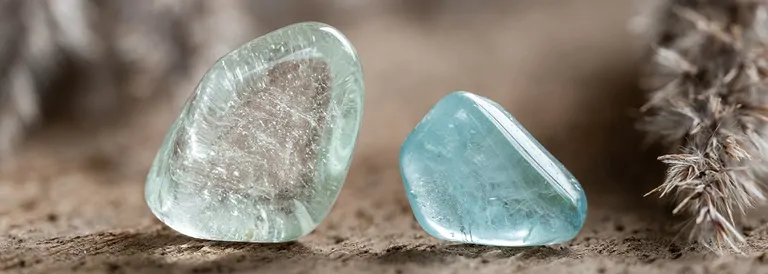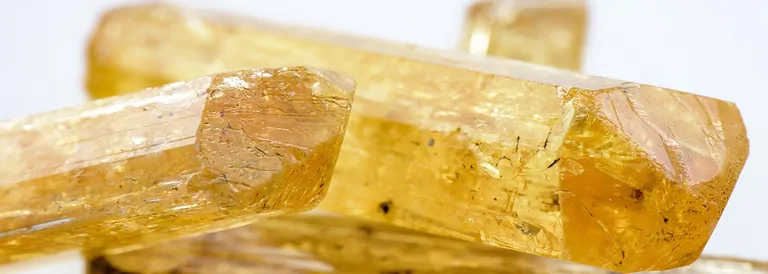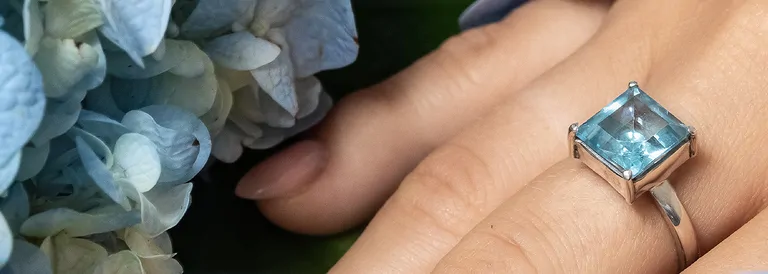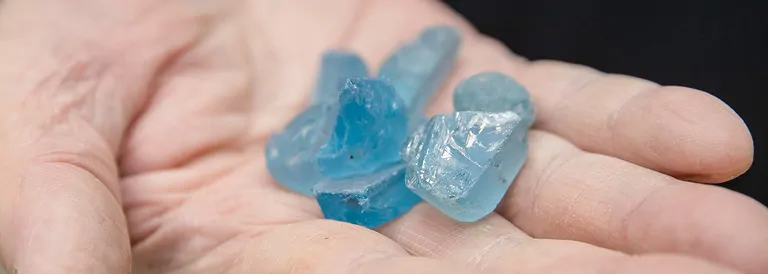
Topaz - meaning, effect and application
Topaz helps us to (re)discover our own inner wealth of images, knowledge and skills. Strengthened in this way, we can realize ourselves and shape life according to our own wishes and ideas. As the year draws to a close, topaz gives us the wisdom that comes from the ups and downs of life. Thanks to topaz, we become aware of the knowledge and experience we have gained over the course of the year and our lives.

Tumbled stones, stringed beads and more topaz items for retailer
Mineralogical profile of topaz
Chemical formula: Al2[(F,OH)2/SiO4]
Mineral class: nesosilicate minerals
Formation: magmatic, lead mineral of pneumatolytic formations following the solidification of acidic deep rocks
Color: colorless; yellow, yellow-gold, pink-red, brown-red, violet, light blue, light green due to impurities
Luster: vitreous luster
Crystal system: orthorhombic
Mohs hardness: 8
Cleavage, fracture: perfect cleavage after the base; uneven fracture
Occurrence, main supplier countries: Brazil, USA, Russia, Sri Lanka, Norway, Mexico, Ukraine, Pakistan
In Germany, the topaz variety pycnite is found in Altenberg (Erzgebirge, Saxony); the Saxon topaz from Schneckenstein is better known (see below).
Appearance: short to long prismatic crystals with extensive terminations, often octagonal cross-section, transparent
Use: Topaz is a popular precious stone and gemstone with a tradition dating back thousands of years. Even in ancient India, it was considered a stone of self-realization. In gemstone healing, topaz is used to discover one's own inner wealth and to live a self-determined life. Astrology uses topaz to emphasize the self-confidence and magnanimity of Leo-born people.

Name and synonyms of topaz
Pliny the Elder traces the name topaz back to the island of Topazos in the Red Sea or to the word “topazin” (to seek). Olivine was mined there for a long time and was confused with topaz for a long time. It is also possible that the name is derived from the Sanskrit word “tapas” for fire or glow.
Naturally blue topaz is also called precious topaz, orange-gold topaz is called imperial topaz or gold topaz. Emperor topaz or king topaz is less common as a name for orange-gold topaz. Today, imperial topaz is only mined in the Capão mine in Minas Gerais. The operator of the mine claims “imperial topaz” as a brand name, which is legally disputed. Pink and purple imperial topaz also originate from Brazil.
The electron-steeled neon blue topaz often found in jewelry is also known as Paraiba topaz. In addition, there are numerous other names for treated blue topazes and their colors, e.g. “London Blue” and “Swiss Blue”.
The following synonyms for topaz are rarely encountered: chrysolite(os), gouttes d'eau (water droplets), perdell (yellow-green), physalite / pyrophysalite, bar stone and camouflage stone.
Misleading names for white, transparent topaz are Flinder's diamond and Killiecrankie diamond (topaz from Killiecrankie, Flinders Island in Tasmania), Mogok diamond, Saxon diamond and slave diamond.
Madeira topaz is a trade name for citrine, smoky topaz is a misleading name for smoky quartz.
Silver jewelry with topaz, stringed beads, crystals and more topaz items for retailer

Topaz as a gemstone
Topaz is considered difficult to work with as the mineral is completely cleavable after the base face. Careless setting and rapid temperature changes can quickly lead to cracks and fissures in topaz.
Topaz can be changed in color by heating, irradiating and steaming. This is how, for example, mystic fire topaz (red coloration through vaporization with titanium) or Indian summer topaz are created.
Significance of topaz in gemstone healing
According to Michael Gienger, topaz is the gemstone of self-realization. The mineral helps people to discover and live out their own inner wealth. It strengthens the natural authority based on knowledge and experience and supports openness and honesty. If developments take a long time and changes are laborious, topaz can help you achieve a breakthrough. A fulfilled emotional life is facilitated by topaz, and wisdom can be gained from the ups and downs of life.
Topaz is popular for use in contemplative meditation to support introspection. A small topaz is also often placed on the crown of the head (white and blue topaz) or the solar plexus (imperial topaz). Worn as a necklace or pendant, topaz provides support in everyday life.
The golden-yellow imperial topaz can help you to show your own abilities to other people in the right light. The striving for recognition is strengthened by the mineral. Imperial topaz makes you proud and more aware of your own abilities. This means that great ideas and plans can be developed and (supposed) limits can be exceeded. Despite all the forward striving, imperial topaz also helps to increase generosity and magnanimity and strengthens groundedness.
Schneckenstein and other famous topazes
The Schneckenstein is a 23m high rock in the transition from the Saxon Vogtland to the Erzgebirge, which originally contained numerous topazes. The yellow topazes have been mined since 1734 and around 2/3 of the original rock has been removed. In 1938, the rock was placed under nature protection, but was still a popular destination for mineralogists and tourists. For this reason, the Schneckenstein has been fenced off since 1973 and is only accessible as part of a museum visit.
The famous yellow topazes from the Schneckenstein were used in the jewelry of Augustus the Strong, which can be admired today in the Grüne Gewölbe in Dresden (Green Vault museum). Topaz from Schneckenstein can also be found in the English royal crown.
More about Schneckenstein topaz
Under favorable formation conditions, topaz crystals can form very large and massive crystals weighing over 100 kg. The largest topaz crystal ever found is said to weigh over 2500kg and be over a meter long; it comes from Ribáuè (Alto Ligonha) in Mozambique. “Lindsay Topaz” and ‘Freeman Topaz’ are two very large topazes, weighing 31.8kg and 50.4kg respectively, which are on public display at the National Museum of Natural History Washington.
The largest polished topaz currently known is “Eldorado”. Found in 1984 in Minas Gerais (Brazil), the 37kg yellow-brown rough stone was cut into an emerald-cut stone weighing 31,000 ct (6.2 kg).
